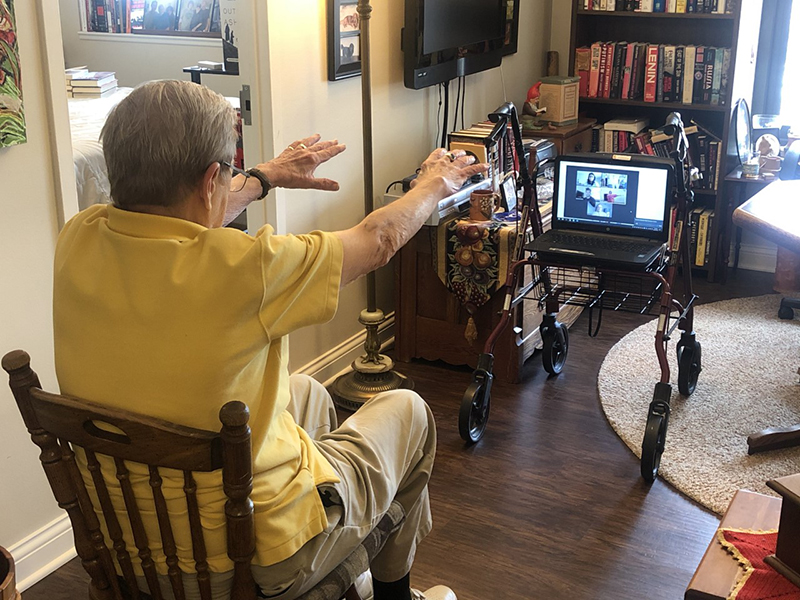May 19, 2021
Pairing telehealth with intergenerational learning presents unexpected lessons for students working with older adults
 A student in the Department of Health and Kinesiology "Balance Rehabilitation" course leads Bill Buffington in an exercise session via telehealth. Buffington, a resident of Westminster Village and professor emeritus in Purdue's School of Languages and Cultures, is one of eight local older adults participating in the course. (Photo provided by Justin Cloud, Westminster Village)
A student in the Department of Health and Kinesiology "Balance Rehabilitation" course leads Bill Buffington in an exercise session via telehealth. Buffington, a resident of Westminster Village and professor emeritus in Purdue's School of Languages and Cultures, is one of eight local older adults participating in the course. (Photo provided by Justin Cloud, Westminster Village)
Undergraduates considering careers in rehabilitation sciences are still able to receive valuable, hands-on career training thanks to innovative telehealth methods.
Purdue University’s Department of Health and Kinesiology has integrated telehealth communication strategies into courses that offer evidence-based exercise plans to older adults. The older adults participating in the virtual courses have been enthusiastic, organizers say, and course leaders have noticed increased attention to communication and creative thinking by their students.
In the fall and spring courses, Balance Rehabilitation in Older Adults, students design and lead an exercise plan tailored to the specific needs and abilities of their older adult participant. In previous semesters, students worked directly with course participants on location at University Place, a continuing care retirement community in West Lafayette. Now students lead the balance and fall-prevention conditioning sessions through telehealth, shorthand for any type of health care provided over electronic communication. The ability to work from home has participants joining from around the community, including Westminster Village, another continuing care community also in West Lafayette.
According to the U.S. Centers for Disease Control and Prevention, more than 3 million older adults receive emergency-room treatment for falls each year, and one out of five falls results in serious injury. The CDC also says exercise programs to improve balance are a key strategy to reduce falls. Students in the course, most considering graduate studies in physical therapy, are trained in age-related changes to motor function, and in creating and leading exercise plans designed to reduce the likelihood of falling.
Doing so electronically offers new considerations for the aspiring therapists. Virtual sessions remove many of the physical and visual signals about a patient’s safety, form or progress that would be readily apparent during an in-person session, forcing students to pay close attention to every aspect of the sessions they are leading.
“When you’re not in person, you have to check in consistently: Are you already standing, are you still holding onto your chair, are your feet still shoulder-width apart?” said Ashwini Kulkarni, a graduate teaching assistant and licensed physical therapist who leads the course.
Course designers, including Kulkarni, have committed to working with whatever technology the participants are comfortable with, whether video, phone or even email. For email, students develop and post videos for the older adult participants to watch, accompanied by written instructions.
“You’re not able to use physical cues like when you are in a room with them, so you really have to rely on expressing yourself through your words. I think this has helped a lot of students learn to make clear, concise instructions,” said Madelyn Delamarter, a recent undergraduate teaching assistant and senior in kinesiology, who graduated in December.
Delamarter, whose mother is a pediatric physical therapist, started the course to gain experience working with different demographics before heading to graduate school. During a regular semester, the course’s intergenerational learning format offers lessons in empathetic communication methods, and telehealth has increased awareness of those skills.
“Students have to figure out how to relate to someone through the screen and still have effective outcomes. It has offered really valuable experience,” Delamarter said.
Kulkarni also said she has noticed a dramatic improvement in various elements of student success, including communication skills, critical thinking and independent learning: “Even when we return to in-person sessions, I would strongly support having some sessions via telehealth.”
The course is instructed by Shirley Rietdyk and Jeffrey Haddad, professor and associate professor of health and kinesiology, and led by Kulkarni and undergraduate teaching assistants who have already completed the course. Rietdyk’s research considers how aging affects balance and mobility, with focus on how the brain and body work together to allow skilled movement in response to environmental hazards. Haddad’s research examines how motor behaviors adapt throughout life to maintain balance in varying circumstances. Purdue’s Center on Aging and the Life Course gave Rietdyk and Haddad the Exceptional Engagement Award for their work on this course in 2012.
Writer: Christy McCarter, mccarter@purdue.edu

